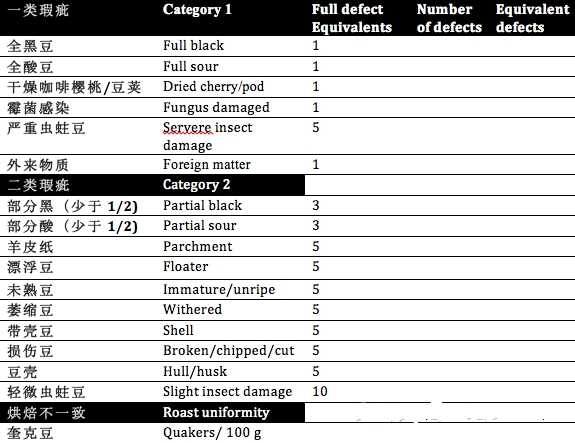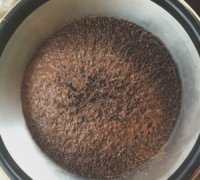Introduction to the varieties of defective coffee beans
Coffee beans have many flaws, and there are a variety of flaws. There are many reasons for defects. Defects may affect our taste experience of coffee at different levels, and may also affect our health. However, many defects that can be clearly seen in raw beans can be quickly invisible once baked. Therefore, most of the coffee cooked beans we usually see are uniform and consistent in appearance, showing a gorgeous brown color, and under the modification of milk and a variety of flavor syrup, its true color and flavor is largely hidden!

Coffee, after all, as a crop, needs to go through a long and arduous process from sowing, planting, harvesting, processing, storage, baking, preservation and production before it reaches our cup and adds color to our life, which is not easy! The emergence of large and small defects is very normal, but it is only a matter of how many. Beans who want to become boutique coffee need to go through many hurdles. All aspects need to be handled carefully and taken seriously. Let's take a look at the grading requirements of SCAA for Arabica boutique coffee.
[defect subdivision type] (350g raw beans)
According to the SCAA Arabica grading standard (refer to the above table), the types of defects in raw coffee beans can be divided into the first category and the second category according to the degree of impact on coffee quality. The two types of defects have different subdivision defect items, and each defective bean has a corresponding number of defects recorded as 1 unit defect. Therefore, after calculating the number of each defect, it should be converted into unit defect number (full defect) respectively. For example, in a class of defects, one all-black bean is recorded as a unit, and five serious worm-eaten beans are also recorded as a unit defect. (less than 5 will not be counted, while 6 will still be counted as a first-class defect of a unit). Among the second-class defects, 3 partially black beans were recorded as a second-class defect, and 10 slightly moth-eaten beans were also recorded as a second-class defect.
Boutique coffee requirements meet:
In the ▶ 350 g raw bean sample, even one unit of first-class defects is not allowed, while the second-class defects cannot exceed 5 units.
No quaker is required in the 100g cooked bean sample of ▶.
[water content]
▶ washed beans: 10% 12%
▶ sun-dried beans: 10% 13%
[smell of raw beans]
▶ has no strange smell.
[raw bean size]
The difference in the dimensions indicated by ▶ in the contract is less than 5%.
★ note: if multiple defects are found in a coffee bean at the same time, the type of defect that has the greatest impact on the quality of the coffee cup should be scored.
The following is a detailed introduction of all kinds of defective beans.
[all black beans / some black beans]
Introduction: raw beans with completely blackened internal or external surfaces are opaque black.
Cause: excessive fermentation caused by organic microorganisms.
Cup test performance: fermentation or smelly, dirty, acidity, mildew taste, phenolic flavor.
[whole sour beans / partial sour beans]
Introduction: fermented raw beans with light yellow or reddish brown as a whole.
Cause: fermentation caused by microbial infection in the process of harvest and treatment. The specific reasons may be: harvesting ripe coffee cherries or coffee cherries that fall on the ground; water pollution during processing; or coffee cherries hanging from trees in wet conditions over-ferment.
Cup test performance: according to the degree of fermentation, there may be odor, acidity, fermentation taste.
Fungal infection]
Introduction: raw beans with yellow or reddish brown because of mildew.
Cause: the temperature and humidity in the process of harvest and storage are suitable for mold breeding.
Cup test performance: may produce fermentation, mildew taste, dirty taste, phenolic flavor.
[foreign matter]
Introduce: foreign body other than coffee such as stone or branch.
Cause: it may occur in any process of raw bean processing.
Cup test performance: let the coffee lose its taste.
[dried coffee cherries / pods]
Introduction: some or all of the raw beans wrapped in black peel.
Causes: the pulp removal process of washing beans is incomplete or the treatment is not complete when the floating matter is removed by entering the water; the treatment of sun-dried beans is not in place in shelling or sorting.
Cup test performance: fermentation, mildew taste, phenolic flavor.
[serious worm-eaten beans / light worm-eaten beans]
Introduction: the worm gnawed out less than 3 (light worm boiled beans) or more than 3 (serious worm boiled beans) raw beans with a diameter of 0.3~1.5mm hole.
Cause: mainly affected by coffee worm (berry borer beetle).
Cup test performance: affect the appearance of ripe beans, may bring dirty flavor, Rio flavor, or mildew flavor.
[broken beans]
Introduction: broken raw beans or fragments of raw beans.
Cause: improper machine debugging in the process of raw bean treatment and pulp removal.
Cup test performance: soil taste, dirty taste, acidity, fermentation.
[uncooked beans]
Introduction: the silver skin is firmly glued to the surface of raw beans, and the bean body is sunken, small in size, sharp at the end, and slightly in the shape of a ship.
Cause: harvesting under immature condition.
The cup test shows that the taste of grass, straw and green astringency are the main sources of the astringency of coffee.
[atrophic beans]
Introduce: wrinkle like raisins, small size, deformed raw beans.
Causes: insufficient water supply and excessive sunshine during development.
Cup test performance: grass flavor, straw flavor.
[shell beans]
Introduction: a shell with thin skin or an abnormal raw bean in the shape of an ear.
Cause: gene.
Cup test performance: scorched taste.
[floating beans]
Introduce: the raw bean that turns white or fades, floats on the water because of its light posture.
Cause: improper storage or drying treatment. Shell beans are left in the corner in the dryer or drying rack to form discolored, low-density beans. Or shell beans are stored in high humidity.
Cup test performance: there may be fermentation, straw flavor, straw flavor, soil flavor, mildew flavor, or it may dilute the flavor without letting the coffee lose its flavor.
[parchment shell beans]
Introduction: dried parchment is completely or partially wrapped with raw beans.
Cause: improper machine calibration in the process of treatment.
[bean shell]
Introduction: with dark pieces of dried fruit.
Causes: the sun-dried beans were not cleaned up in the process, and the pulp removal machine was improperly calibrated.
Cup test performance: can bring dirty taste, soil flavor, mildew flavor, fermentation flavor, phenolic flavor.
[Quick beans]:
Introduction: it is not fully fried when baking, and the color is far lighter than other coffee cooked beans.
Important Notice :
前街咖啡 FrontStreet Coffee has moved to new addredd:
FrontStreet Coffee Address: 315,Donghua East Road,GuangZhou
Tel:020 38364473
- Prev

Relationship between Coffee Grinding, Coffee extraction ratio and concentration
In the coffee training class, the exchange, discussion and summary of extraction are in full swing. The following is the teaching summary of the trainers in our school. Coffee extraction is like doing an experiment, controlling the change between solvent (water) and solute (coffee) under environmental variables. How to dissolve the effective substances in coffee according to demand under appropriate conditions is the tireless work of all coffee lovers.
- Next

Quality Coffee Encyclopedia Coffee Coffee commonly used in English
Whether you are a barista or an enthusiast, when you start to like coffee, you are destined to deal with a lot of technical terms, and the following common words will be the golden key to unlock your coffee password. [Barista] the English name of a barista is everyone who stands in front of the coffee machine and is familiar with every method of making coffee drinks and who can make your own coffee. And mixing drinks.
Related
- Beginners will see the "Coffee pull flower" guide!
- What is the difference between ice blog purified milk and ordinary milk coffee?
- Why is the Philippines the largest producer of crops in Liberia?
- For coffee extraction, should the fine powder be retained?
- How does extracted espresso fill pressed powder? How much strength does it take to press the powder?
- How to make jasmine cold extract coffee? Is the jasmine + latte good?
- Will this little toy really make the coffee taste better? How does Lily Drip affect coffee extraction?
- Will the action of slapping the filter cup also affect coffee extraction?
- What's the difference between powder-to-water ratio and powder-to-liquid ratio?
- What is the Ethiopian local species? What does it have to do with Heirloom native species?

